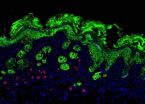(Press-News.org) VIDEO:
This video shows the "dipping " technique performed by chimpanzee Ayumu. Note that he uses his mouth to insert the tube into the bottle. In form, his technique is identical to...
Click here for more information.
Chimps can learn more efficient ways to use a tool by watching what others do, according to research published January 30 in the open access journal PLOS ONE by Shinya Yamamoto and colleagues from Kyoto University and Kent University, UK. Their study presents the first experimental evidence that chimps, like humans, can watch and learn a group member's invention of a better technique.
VIDEO:
This video shows close observation and a subsequent switch in technique. Pal (out of sight in the first view) closely observes the demonstrator, then fetches a tube from the floor...
Click here for more information.
Chimps in the study were provided juice-boxes with a small hole and straws to drink with. One group of chimps used the straws like dipsticks, dipping and removing them to suck on the end, while the other group learned to suck through the straw directly. Learning both techniques required the same cognitive and motor skills, but chimps that drank through the straw got considerably more juice in a shorter amount of time. When the first group of chimps watched either a human or a chimp demonstrate the more efficient 'straw-sucking' technique, all of them switched to using this instead. The study concludes, "When chimpanzees are dissatisfied with their own technique, they may socially learn an improved technique by closely observing a proficient demonstrator."
According to the authors, their results provide insights into the cognitive basis for the evolution of culture in chimpanzees, and suggest ways that culture could evolve in non-human animals.
###
Citation: Yamamoto S, Humle T, Tanaka M (2013) Basis for Cumulative Cultural Evolution in Chimpanzees: Social Learning of a More Efficient Tool-Use Technique. PLOS ONE 8(1): e55768. doi:10.1371/journal.pone.0055768
Financial Disclosure: The present study was financially supported by grants-in-aid from the Ministry of Education, Culture, Sports, Science and Technology in Japan (MEXT: 20002001, 24000001, and MEXT special grant ''Human Evolution'' to T. Matsuzawa) and from Japan Society for the promotion of Science (JSPS: 18-3451, 21-9340, 22800034 and 40585767 to S. Yamamoto). The funders had no role in study design, data collection and analysis, decision to publish, or preparation of the manuscript.
Competing Interest Statement: The authors have declared that no competing interests exist.
PLEASE LINK TO THE SCIENTIFIC ARTICLE IN ONLINE VERSIONS OF YOUR REPORT: http://dx.plos.org/10.1371/journal.pone.0055768
(URL goes live after the embargo ends) END
Chimp see, chimp learn: First evidence for chimps improving tool use techniques by watching others
Chimps learn to make improvements to their tool-use technique by watching peers
2013-01-31
ELSE PRESS RELEASES FROM THIS DATE:
Tapeworm eggs discovered in 270 million year old fossil shark feces
2013-01-31
A cluster of tapeworm eggs discovered in 270-million-year-old fossilized shark feces suggests that intestinal parasites in vertebrates are much older than previously known, according to research published January 30 in the open access journal PLOS ONE by Paula Dentzien-Dias and colleagues from the Federal University of Rio Grande, Brazil.
Remains of such parasites in vertebrates from this era are rare- of 500 samples examined, only one revealed the tapeworm eggs. This particular discovery helps establish a timeline for the evolution of present-day parasitic tapeworms ...
Pact invests US $109 million to secure critical genetic material, maintain global food production
2013-01-31
Contact: Michelle Geis
mgeis@burnesscommunications.com
301-280-5712
Contact: Susan Tonassi
301-280-5711
stonassi@burnesscommunications.com
Pact invests US $109 million to secure critical genetic material, maintain global food production
CGIAR consortium partners with global crop diversity trust to revitalize genebanks housing scores of crops considered essential to food security
BONN, GERMANY (31 JANUARY 2013)—Concerned that inconsistent funding eventually could weaken a global network of seed banks at a time when farmers face unprecedented challenges, two ...
Forsyth scientists gain new understanding of latent tuberculosis
2013-01-31
Scientists at the Forsyth have gained new insight on how Tuberculosis (TB) remains a global epidemic. Although drugs have been available to fight TB for 50 years, the disease still infects nearly 2.2 billion people worldwide and causes 1.7 million annual deaths. This is largely attributed to the bacteria's ability to stay dormant in the human body and later resurface as active disease. The Forsyth team, and its collaborators from Stanford University, has recently discovered that Mycobacterium tuberculosis, the bacteria that causes TB, can lay dormant and thrive within ...
Itching for new help for eczema: Recently identified immune cells possible therapeutic target
2013-01-31
PHILADELPHIA - The increasing incidence of allergic skin diseases, and the accompanying economic burden and heightened risk of developing other allergic conditions, have spurred researchers to look for better ways to control these immune system-based disorders.
Atopic dermatitis, more commonly called eczema, now affects 10 to 20 percent of children in the United States and direct health-care costs exceed $3 billion, according to the National Institute of Arthritis and Musculoskeletal and Skin Diseases. What's more, up to 50 percent of children with atopic dermatitis ...
Scientists may have received millions in duplicate funding
2013-01-31
Big Data computation at the Virginia Bioinformatics Institute at Virginia Tech reveals that over the past two decades funding agencies may have awarded millions and possibly billions of dollars to scientists who submitted the same grant request multiple times — and accepted duplicate funding.
An analysis led by Harold R. Garner, a professor at Virginia Tech, not only indicates that millions in funding may have been granted and used inappropriately, it points to techniques to uncover existing instances of duplicate funding and ways to prevent it in the future. The analysis ...
Setting the stage for a new paradigm in treatment of heart failure
2013-01-31
CHAPEL HILL, N.C. – Despite a substantial increase in the number of people suffering the debilitating and often deadly effects of heart failure, treatments for the condition have not advanced significantly for at least 10 years. An analysis by researchers at the University of North Carolina School of Medicine shows new breakthroughs could be closer than we thought.
The analysis points to striking similarities between heart cells in patients with heart failure and brain cells in patients with Alzheimer's disease, raising the possibility that some treatment approaches being ...
Current evidence does not support selenium for preventing heart disease in well-nourished adults
2013-01-31
A systematic review published today in The Cochrane Library finds that in well-nourished adults current evidence does not support selenium for preventing heart disease. The review suggests that taking selenium supplements does not reduce a person's risk of developing heart disease, although most evidence is currently limited to healthy American adults.
Diet is a key factor influencing heart disease risk. Selenium is one dietary element that could potentially play a role in preventing heart disease by protecting against oxidative stress and inflammation. It is a common ...
Brain activity study lends insight into schizophrenia
2013-01-31
Magnetic fields produced by the naturally occurring electrical currents in the brain could potentially be used as an objective test for schizophrenia and help to better understand the disease, according to new research published today.
A team of researchers from Plymouth and Spain have used the non-invasive magnetoencephalogram (MEG) technique to find two spectral features that are significantly different in schizophrenia patients compared to healthy control subjects.
Furthermore, they found that there were four spectral features in the brain signals of schizophrenia ...
Dementia: Cerebrolysin shows promise
2013-01-31
Dementia patients may benefit from a promising new treatment called Cerebrolysin, according to the results of a systematic review published in The Cochrane Library. The authors brought together the most up-to-date evidence on Cerebrolysin as a treatment for vascular dementia.
Vascular dementia is a common form of dementia caused by damage to the network of blood vessels supplying the brain. Some of the symptoms are similar to those associated with Alzheimer's disease and stroke but in particular those with vascular dementia often experience difficulty thinking quickly, ...
Chronic hepatitis C: Interferon may be harmful in re-treatment
2013-01-31
People with hepatitis C and chronic liver disease who relapsed or failed to respond to initial treatment are unlikely to improve on interferon retreatment. In fact, they may face an increased risk of dying sooner, and are likely to experience a variety of adverse effects, according to an updated systematic review published in The Cochrane Library.
Hepatitis C affects around 170 million people worldwide. In some cases, infection leads to chronic liver disease, liver failure or liver cancer, eventually resulting in death. Treatment is based on antiviral drugs.
Interferon ...
LAST 30 PRESS RELEASES:
New expert guidance urges caution before surgery for patients with treatment-resistant constipation
Solar hydrogen can now be produced efficiently without the scarce metal platinum
Sleeping in on weekends may help boost teens’ mental health
Study: Teens use cellphones for an hour a day at school
After more than two years of war, Palestinian children are hungry, denied education and “like the living dead”
The untold story of life with Prader-Willi syndrome - according to the siblings who live it
How the parasite that ‘gave up sex’ found more hosts – and why its victory won’t last
When is it time to jump? The boiling frog problem of AI use in physics education
Twitter data reveals partisan divide in understanding why pollen season's getting worse
AI is quick but risky for updating old software
Revolutionizing biosecurity: new multi-omics framework to transform invasive species management
From ancient herb to modern medicine: new review unveils the multi-targeted healing potential of Borago officinalis
Building a global scientific community: Biological Diversity Journal announces dual recruitment of Editorial Board and Youth Editorial Board members
Microbes that break down antibiotics help protect ecosystems under drug pollution
Smart biochar that remembers pollutants offers a new way to clean water and recycle biomass
Rice genes matter more than domestication in shaping plant microbiomes
Ticking time bomb: Some farmers report as many as 70 tick encounters over a 6-month period
Turning garden and crop waste into plastics
Scientists discover ‘platypus galaxies’ in the early universe
Seeing thyroid cancer in a new light: when AI meets label-free imaging in the operating room
Neutrophil-to-lymphocyte ratio may aid risk stratification in depressive disorder
2026 Seismological Society of America Annual Meeting
AI-powered ECG analysis offers promising path for early detection of chronic obstructive pulmonary disease, says Mount Sinai researchers
GIMM uncovers flaws in lab-grown heart cells and paves the way for improved treatments
Cracking the evolutionary code of sleep
Medications could help the aging brain cope with surgery, memory impairment
Back pain linked to worse sleep years later in men over 65, according to study
CDC urges ‘shared decision-making’ on some childhood vaccines; many unclear about what that means
New research finds that an ‘equal treatment’ approach to economic opportunity advertising can backfire
Researchers create shape-shifting, self-navigating microparticles
[Press-News.org] Chimp see, chimp learn: First evidence for chimps improving tool use techniques by watching othersChimps learn to make improvements to their tool-use technique by watching peers


